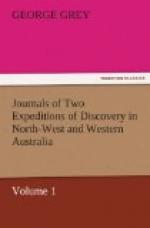Sandstone caverns.
Some distance from the top of the cascade I discovered a cavern, or rather huge hole in the water-course, into which, thinking it might contain fossil bones, I descended as far as the first ledge, and I then perceived that the water pouring through this cavern in the rainy season was cutting off another rock of sandstone similar to the remarkable pillar in front of the cascade. The water in the basin below must have filtered out from this cavern. On a further examination I found that a precisely similar series of operations was going on throughout the whole amphitheatre of cliffs which bounded the tableland we had been traversing during the morning.
In the rainy season (March 7th) I again passed this spot and found the watercourse full of water, which was also falling abundantly from the cascade. From this circumstance I inferred that the subterraneous outlets for the water were all filled, consequently the large body which these caverns would contain must have been then endeavouring to force its way through the fissures in the porous sandstone rocks.
Continuation of route. Halt in A valley.
After breakfast we continued on our route through a sandstone country precisely resembling the one which I have now described, and in the course of the day, having completed fifteen miles in a straight line, we halted for the night in a fertile valley affording plenty of fresh water, and so densely wooded with the dwarf pandanus and other prickly trees that we could scarcely make our way through the underwood. In this valley we saw several sorts of cranes, principally Ardea antigone, and Ardea scolopacia, and I shot one of the former kind and laid it by, intending to eat it in the morning. We could not find any holes in the rocks large enough to protect us from the rain, which fell throughout the night, accompanied by thunder and lightning.
December 20.
Just as we turned out this morning a large kangaroo came close to us to drink at a waterhole; the effect as it stole along through the thick bushes in the morning twilight was very striking. I could not succeed in getting a shot at it; but, as I was determined to have a meat breakfast, I desired Mustard to cook the crane, the rats however had eaten the greater part of it; we therefore at once moved on and, after travelling four miles in a south-east direction over good land, we reached a valley, the largest and best I had yet seen, containing trees and birds such as we had not before met with; kangaroos were more plentiful, and, for the first time, we saw the opossum. The valley was more than a mile in width at the point where we first made it, and we had but just time to cross it and to gain the partial shelter of some rocks when heavy rain again set in. We could keep no fire and, being soon wet through, passed a wretched night.
December 21.




